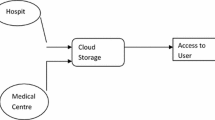Abstract
Bleeding in the digestive tract is one of the most common gastrointestinal (GI) tract diseases, as well as the complication of some fatal diseases. Wireless capsule endoscopy (WCE), which is widely applied in the clinical field, allows physicians to noninvasively examine the entire GI tract. However, it is very laborious and time-consuming to detect the huge amount of WCE images, and limits its wider application. It is urgent and necessary to develop the automatic and intelligent computer aided bleeding detection technique. This paper improves the Euler distance with the covariance matrix of image to measure the colour similarity in CIELab colorimetric system, and proposes a novel method of bleeding detection in WCE images. The experiments demonstrate that the bleeding region in WCE images can be correctly recognized and marked out, and the sensitivity of this method is 92%, the specificity is 95%.
Similar content being viewed by others
References
National Digestive Diseases Information Clearinghouse. Bleeding in the digestive tract [M]. Bethesda, Maryland: National Institutes of Health, 2007: 1–6.
Eliakim R, Suissa A, Yassin K, et al. Wireless capsule video endoscopy compared to barium follow-through and computerised tomography in patients with suspected Crohn’s disease-final report [J]. Digestive and Liver Disease, 2004, 36(8): 519–522.
Iddan G, Meron G, Glukhovsky A, et al. Wireless capsule endoscopy [J]. Nature, 2000, 405(6785): 417.
Swain P, Iddan G J, Meron G, et al. Wireless capsule endoscopy of the small bowel: development, testing, and first human trials [C]// Biomonitoring and Endoscopy Technologies. Amsterdam, Netherlands: SPIE, 2001: 19–23.
Delvaux M, Gay G. Capsule endoscopy in 2005: Facts and perspectives [J]. Best Practice & Research in Clinical Gastroenterology, 2006, 20(1): 23–39.
Pennazio M. Capsule endoscopy: Where are we after 6 years of clinical use? [J]. Digestive and Liver Disease, 2006, 38(12): 867–878.
Sturniolo G C, Leo V D, Vettorato M G, et al. Small bowel exploration by wireless capsule endoscopy: Results from 314 procedures [J]. American Journal of Medicine, 2006, 119(4): 341–347.
Abdullah B, Ruzyla T. Wireless capsule endoscopy: A pediatric experience [J]. American Journal of Gastroenterology, 2008, 103: S53.
Golding M, Doman D, Goldberg H. Use of wireless capsule endoscopy for evaluation of sustained gastric presence of a polymer medication delivery system [J]. American Journal of Gastroenterology, 2008, 103: S41.
Muhammad A, Khara H, BajaJ P, et al. A singlecenter experience of 831 patients with wireless capsule endoscopy [J]. American Journal of Gastroenterology, 2008, 103: S510.
Buscaglia J M, Giday S A, Kantsevoy S V, et al. Performance characteristics of the suspected blood indicator feature in capsule endoscopy according to indication for study [J]. Clinical Gastroenterology and Hepatology, 2008, 6(3): 298–301.
Mackiewicz M, Fisher M, Jamieson C. Bleeding detection in wireless capsule endoscopy using adaptive colour histogram model and support vector classification [C]// Medical Imaging 2008 Conference. San Diego, CA: SPIE-Int Soc Optical Engineering, 2008: R1–R12.
Bourbakis N, Makrogiannis S, Kavraki D, et al. A neural network-based detection of bleeding in sequences ofWCE images [C]// 5th IEEE Symposium on Bioinformatics and Bioengineering. Minneapolis, MN: IEEE Computer Soc, 2005: 324–327.
Li B P, Meng Q H. Computer aided detection of bleeding in capsule endoscopy images [C]// 2008 Canadian Conference on Electrical and Computer Engineering. Niagara Falls, Canada: IEEE, 2008: 1875–1878.
Takagi M, Shimoda H. Handbook of image analysis [M]. Beijing: Science Press, 2007: 428–440 (in Chinese).
Altman D G, Bland J M. Diagnostic tests. 1. Sensitivity and specificity [J]. BMJ, 1994, 308(6943): 1552.
Author information
Authors and Affiliations
Corresponding author
Additional information
Foundation item: the National High Technology Research and Development Program (863) of China (No. 2006AA04Z368), the National Natural Science Foundation of China (No. 30570485)
Rights and permissions
About this article
Cite this article
Pan, Gb., Yan, Gz., Song, Xs. et al. Bleeding detection from wireless capsule endoscopy images using improved euler distance in CIELab. J. Shanghai Jiaotong Univ. (Sci.) 15, 218–223 (2010). https://doi.org/10.1007/s12204-010-9716-z
Received:
Published:
Issue Date:
DOI: https://doi.org/10.1007/s12204-010-9716-z




